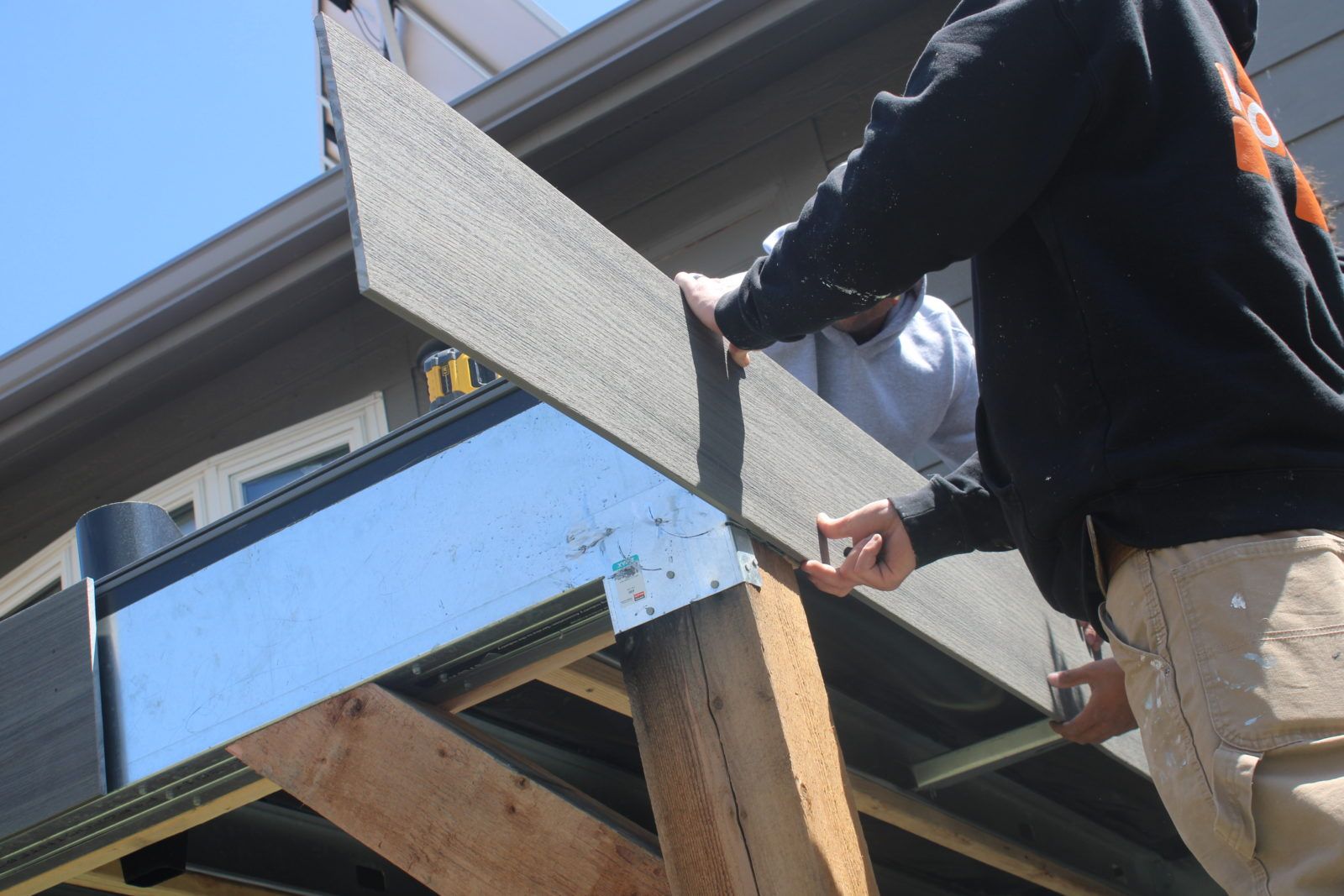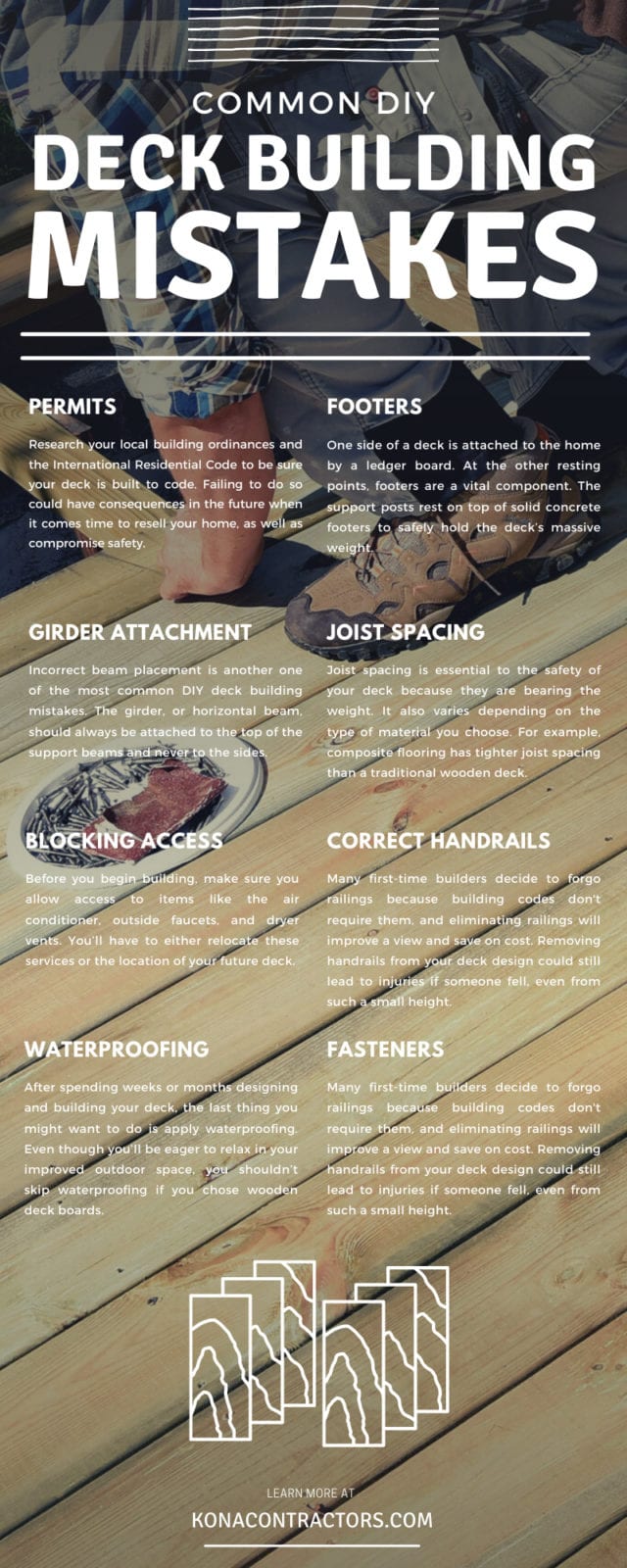
Common DIY Deck Building Mistakes
A beautifully crafted deck can make a desolate yard into an inviting space perfect for entertaining. A deck can expand your living space during warmer months. Even though building a deck might seem easy, even the most experienced handyman can make mistakes that could compromise the project’s efficiency or safety.
Before you get out your tools, be sure to check out these common DIY deck building mistakes and avoid pitfalls that could ruin summer get-togethers.
Permits
An often overlooked step in building your deck is securing the correct permits. Research your local building ordinances and the International Residential Code to be sure your deck is built to code. Failing to do so could have consequences in the future when it comes time to resell your home, as well as compromise safety.
Footers
One side of a deck is attached to the home by a ledger board. At the other resting points, footers are a vital component. The support posts rest on top of solid concrete footers to safely hold the deck’s massive weight. Here are measurements to be sure your footing is installed accurately:
- Footers need to run deep. In some cases, the footing will need to be run as deep as 48 inches.
- Frost can compromise the stability of your deck’s footing. Footers need to run 12 inches below grade to avoid problems with frost.
- Deck footing must be at least an inch above the ground to ensure they stay dry.
Girder Attachment
Incorrect beam placement is another one of the most common DIY deck building mistakes. The girder, or horizontal beam, should always be attached to the top of the support beams and never to the sides. Some rookie deck builders attach the girder to the sides of the support beams. This can lead to a deck collapse as bolts can easily strip or weaken.
Attaching the girder can be done in two ways: with metal column caps, or by notching them in with a circular saw. Metal support caps rest on top of the support beams while notching out space can allow the girder to nestle safely inside a pocket within the support beams. For both methods, it’s important to secure the horizontal beam with galvanized fasteners.
Joist Spacing
Like the flooring in a home, your deck flooring rests on milled or repurposed lumber called joists. While houses have subflooring to help distribute the weight, decks do not. The floorboards of decks are attached directly to the joists.
Joist spacing is essential to the safety of your deck because they are bearing the weight. It also varies depending on the type of material you choose. For example, composite flooring has tighter joist spacing than a traditional wooden deck.
Material
Consider your needs when you’re choosing material for your deck. Cost-effective deck boards like composite or pressure-treated are great for smaller budgets as well as being low maintenance. Higher budgets can support more exotic wooden boards.
Ledger Board
The ledger board should always be attached to the most stable part of the house, the rim joist. A common mistake is attaching the board over the top of the siding of your home. The bolts are unable to reach the structure due to the siding and insulation. Connecting the ledger board over the top of the siding makes your deck unstable.
To properly attach the ledger board, remove the siding, insulation, and tar paper so you can affix the board to the rim joist.
Blocking Access
Another deck building mistake is blocking access to services, as well as preventing egress from basement windows. Before you begin building, make sure you allow access to items like the air conditioner, outside faucets, and dryer vents. You’ll have to either relocate these services or the location of your future deck. Otherwise, local officials could deny your building permit.
Fasteners
Ensuring you’re using the correct fastener is of the utmost importance when building your deck. The wrong hardware can have severe consequences like a deck collapse. Deck fasteners are susceptible to corrosion due to exposure from the elements and reactions from the deck floorboards.
To avoid catastrophes, you need to use hardware approved for decks like galvanized steel or coated materials.
Correct Handrails
Many building codes don’t require handrails for decks that are under thirty inches tall. Many first-time builders decide to forgo railings because building codes don’t require them, and eliminating railings will improve a view and save on cost. Removing handrails from your deck design could still lead to injuries if someone fell, even from such a small height.
Consider other handrail options to preserve your view and the budget. Glass panels can maintain your view and add a modern style to your deck. Choosing composite deck boards would allow you to have room in your budget for handrails.
Waterproofing
After spending weeks or months designing and building your deck, the last thing you might want to do is apply waterproofing. Even though you’ll be eager to relax in your improved outdoor space, you shouldn’t skip waterproofing if you chose wooden deck boards.
If you decided on composite flooring, waterproofing isn’t necessary.
Composite Decks
Choosing between a composite or wood material for your deck is a decision that deserves some consideration. Composite decks have advantages that wooden decks do not:
- Splinters – Composite is made from tiny wood fibers surrounded by plastic. Splinters are a thing of the past.
- Insect Resistant – Decks made from composite flooring are resistant to termites and other pests.
- Easier Maintenance – Wood decks require regular maintenance like painting, staining, and stealing to protect the floorboards from the elements. Composites only need the occasional sweep or wash.
- Appearance – Despite being partially made from plastic, composite decking has a grain pattern giving it the appearance of wooden decks.
- Cost – Even though composite deck material is initially more expensive, wooden deck costs add up over the years due to continuous maintenance.
Find a Professional
Building a deck isn’t an easy task. Novice builders can build beautiful decks after they understand the issues that can cause problems. But concerns and issues might still arise. You could end up with an unfinished deck in your backyard.
Make the process easier and find a professional to build your deck. Contact Kona Contractors when you’re looking for Denver deck installation experts. Our deck contractors can add a beautiful backyard deck to your home!

